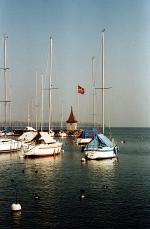|
Balda 504 electronic |

Manufactured or assembled in Germany from (Circa) 1968 to (After) 1968.
Index of rarity in France: Rare (among non-specialized garage sales)
Inventory number: 15036
See the complete technical specifications
Chronology of cameras Balda
Balda followed Kodak in the path of the 126 and released a whole range of cameras using the new film cartridge.
Film and 126 Camera
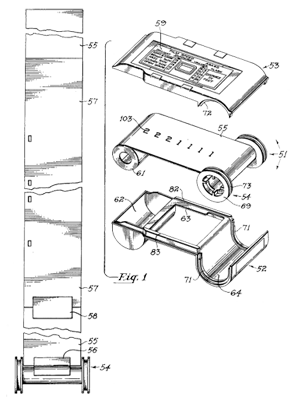 The patent 3,138,081 was published on June 23, 1964. It was filed by Kodak, and the inventor's name is Hubert Nerwin.
The patent 3,138,081 was published on June 23, 1964. It was filed by Kodak, and the inventor's name is Hubert Nerwin.
It involves a 35mm film contained within a closed cassette. Asymmetric, it serves both as a supply spool and a take-up spool. There is no possibility of inserting the film the wrong way in the camera due to its design. The film is perforated on one side only. The back is lined with paper bearing a frame number, employing the principle of an unexposed back on cameras to avoid the need for a mechanical frame counter. The camera only requires one drive spindle since there's no need to rewind the film. The cassette is returned to the Kodak laboratory after the final exposure without any additional handling.
With this innovative system, the photographer no longer runs the risk of mispositioning the film start tab or tearing the perforations. Also known as Kodapak, the 126 film was available in 20, later in 24 exposures (the 12-exposure version existed for a short time), either in color negative or for colour slides.
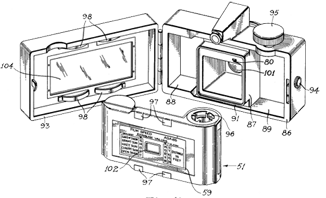
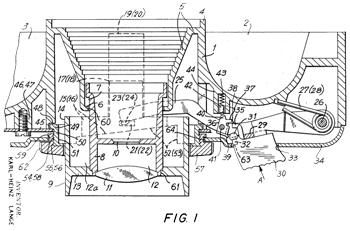 The shape of the cameras changed during the series' existence. The shutter release of the early models is integrated into the front face and is black (Design 1).
The shape of the cameras changed during the series' existence. The shutter release of the early models is integrated into the front face and is black (Design 1).Later, it is larger and forms the top and left edge of the front face (Design 2).
The most advanced models change in design. The lens is retractable (Design 3). The mechanism for the movement of the lens was the subject of several patents filed in 1971 by Balda. The inventor was Karl-Heinz Lange (US3709129 and DE2136183).
| Years | Lens | Shutter | Design | Misc. | ||
| Models using Flashcube | ||||||
| 104 |  |
c.1968 | Fixfocus | Single speed | 1 | Winding knob. No setup. Fake cell |
| 304 | c. 1968 | Fixfocus | 1/60 | 1 | Like 104, but automatic exposure | |
| 504 electronic |  |
c. 1968 | Fixfocus | 18 to 1/250 | 1 | CdS cell |
| 544 electronic | c.1972 | Fixfocus | 1 | |||
| 644 electronic | c.1972 | Symbols | 1 (?) | |||
| 144 |  |
c.1971-77 | Fixfocus | Single speed | 2 | Winding knob. No setup |
| 344 | c.1972 | Fixfocus | 2 | Like 144, but automatic exposure | ||
| 844 electronic | 1971-77 | 18 to 1/300 | 3 | CdS cell, Light signals in the viewfinder. Retractable lens | ||
| Models using Magicube | ||||||
| 144-X |  |
1971-77 | Fixfocus | Single speed | 2 | Winding knob. No setup |
| 344-X | c. 1972 | Fixfocus | 2 | Like 144-X, but automatic exposure | ||
| 824-X | c. 1974-77 | 1/40 and 1/125 | 3 | Collimated viewfinder. Retractable lens | ||
| 834-X | c.1974-77 | 3 | Lights in the viewfinder indicating the setting (sun, shade, or flash). Retractable lens | |||
| 844-X electronic | c.1972-77 | 18 to 1/300 | 3 | CdS cell, Light signals in the viewfinder. Retractable lens | ||
| 944-X electronic | c.1974-77 | Isconar 5.6/35 Fixfocus | 8 to 1/1000 | 3 | CdS cell. Retractable lens | |
__________
This modest-looking compact camera is, however, equipped with an electronic shutter and a CdS cell, allowing for a range of shutter speeds from 18 seconds to 1/250.
A red light signal appears in the viewfinder to indicate the risk of camera shake with slow shutter speeds.
This particular unit was sold by Photo-Ciné Besançon.
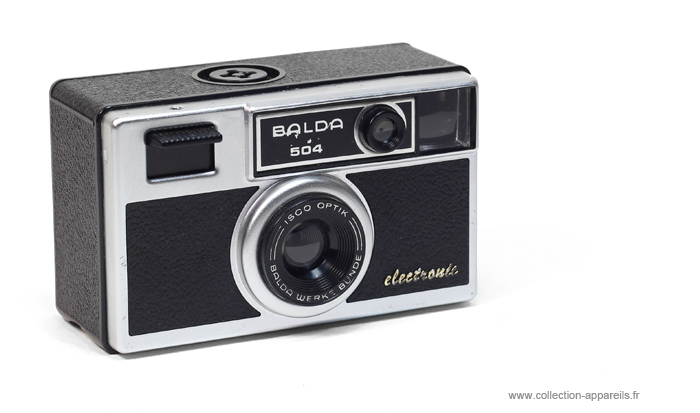
Flashcube
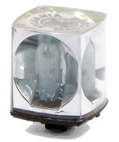
The Flashcube is covered by the patent 3,327,105, published on June 20, 1967. It was filed by Sylvania, an American company from Massachusetts. The inventors are Franklin D. Kottler, Clifford G. Vroom, and Dean M. Peterson.
The Flashcube is a set of four bulbs protected by a transparent plastic cap, designed in the shape of a cube. Under the base of the cube, two metal wires establish contact with the electrical circuit of the camera for each of the bulbs.
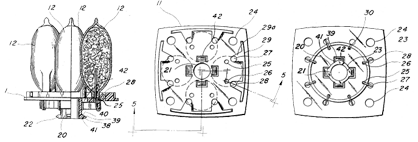
The patent 3,327,106 filed by Sylvania on June 20, 1967, and with Franklin D. Kottler as the inventor, defines the connection method for cameras. Patent number 3,335,651, filed by Kodak and with Franklin D. Kottler and Francis A. Williams as inventors, explains the rotational system of the Flashcube for cameras utilizing it.
Several other patents from the same era indicate that Franklin D. Kottler worked for both Sylvania and Kodak.
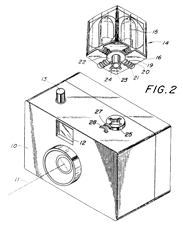

Interesting links or bibliography :
Add a link or element of bibliography, a picture taken with this camera, a picture of box or an ads about this camera
Your photos taken with the same camera:
Cameras from Ebay France (Balda) (Uploaded each 3 hours)
 Appareil photo Balda Super Baldina objectif Hugo Meyer Trioplan 5 cm f 2.9 79,00 euros Finira le 19-05-2024 à 19:51:09 |  ANCIEN APPAREIL PHOTO A SOUFFLET BALDAXETTE BALDA VINTAGE 60,00 euros Finira le 20-05-2024 à 18:48:21 |  appareil photo BALDA SUPER MATIC OBJECTF BALDANAR 1: 2,8/45 obturateur COMPUR 45,00 euros Finira le 19-05-2024 à 21:48:13 |  APPAREIL PHOTO ARGENTIQUE BALDA BALDESSA LF objectif GOTTINGEN ISCONAR 1:2,8/45 30,00 euros Finira le 19-05-2024 à 21:50:10 |  KODAK INSTAMATIC 33 APPAREIL PHOTO ANCIEN DE COLLECTION §92 1,00 euros Finira le 22-05-2024 à 17:26:04 |  Balda Rollbox Collection appareils photo anciens 10,00 euros Finira le 22-05-2024 à 18:51:48 |  Vend appareil photos Allemand BALDA Baldalette 1950 23,00 euros Finira le 25-05-2024 à 15:32:12 |







